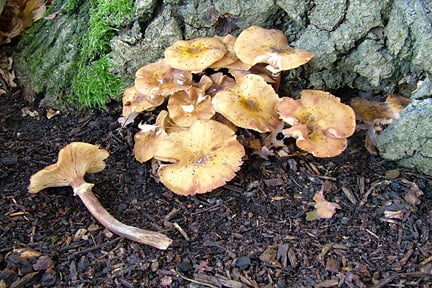Honey fungus
Honey fungus is the common name given to several different species of the fungus Armillaria that attack and kill the roots of many woody and perennial plants. The most characteristic symptom of honey fungus is white fungal growth between the bark and wood, usually at ground level. Clumps of honey-coloured mushrooms sometimes appear briefly on infected stumps in autumn.

Quick facts
Scientific name Armillaria (several species)
Plants affected Many woody and herbaceous perennials
Main symptoms Decaying roots, white fungus between bark and wood, rhizomorphs, sudden death of plant
Caused by Fungus
Timing Mycelium and rhizomorphs present all year, mushrooms only late-summer to autumn
What is honey fungus?
Honey fungus is the common name of several species of fungi within the genus Armillaria. Honey fungus spreads underground, attacking and killing the roots of perennial plants and then decaying the dead wood. It is the most destructive fungal disease in UK gardens.
Honey fungus can attack many woody and herbaceous perennials. No plants are completely immune, but there are some that are only rarely recorded as being affected (see the 'Control' section below).
Aesculus, Betula (birch), Buddleja, Ceanothus, Cedrus, Cercidiphyllum, Cotoneaster, × Cuprocyparis leylandii (leyland cypress), Forsythia, Juglans, Laburnum, Ligustrum (privet), Liquidambar, Photinia, Quercus, Rhododendron (azalea), Salix (willow), Sorbus, Syringa (lilac), Thuja, Viburnum and Weigela are all particularly susceptible to honey fungus.
Symptoms
Some of the symptoms you may see:
Above ground
- Upper parts of the plant die. Sometimes suddenly during periods of hot dry weather, indicating failure of the root system; sometimes more gradually with branches dying back over several years
- Smaller, paler-than-average leaves
- Failure to flower or unusually heavy flowering followed by an unusually heavy crop of fruit (usually just before death of the plant)
- Premature autumn colour
- Cracking and bleeding of the bark at the base of the stem
- If suitable conditions permit, mushrooms are produced in autumn from infected plant material
Below ground
- Dead and decaying roots, with sheets of white fungus material (mycelium) between bark and wood, smelling strongly of mushrooms. This can often be detected at the collar region at ground level, and more rarely spreads up the trunk under the bark for about 1m (3¼ft). This is the most characteristic symptom to confirm diagnosis
- Rhizomorphs (see images 2, 3 and 4 above) are often difficult to detect, especially for the most pathogenic species, and they are particularly difficult to find in the soil
Control
There are no chemicals available for control of honey fungus. If honey fungus is confirmed, the only effective remedy is to excavate and destroy, by burning or landfill, all of the infected root and stump material. This will destroy the food base on which the rhizomorphs feed and they are unable to grow in the soil when detached from infected material.
Non-chemical control
To prevent honey fungus spreading to unaffected areas, a physical barrier such as a 45cm (18in) deep vertical strip of butyl rubber (pond lining) or heavy duty plastic sheet buried in the soil will block the rhizomorphs. It should protrude 2-3cm (about 1in) above soil level. Regular deep cultivation will also break up rhizomorphs and limit spread.
Avoid the most susceptible plants and instead use plants that are rarely recorded as being affected by honey fungus. Some less affected plants include: Arundinaria (and other bamboos), Buxus sempervirens, Callicarpa, Catalpa, Chaenomeles, Chimonanthus, Cordyline, Erica, Garrya, Ginkgo, Hypericum, Jasminum, Pittosporum, Rhamnus, Sarcococca, Tamarix, and Vaccinium.
See this link for a more complete list of susceptible and less affected plants.
Chemical control
There are no chemical controls available.
Biology
There are seven species of Armillaria in the UK. The most common species in gardens are A. mellea and A. gallica. There is a rarer occurrence of A. ostoyae. The remaining species A. cepistipes, A. tabescens, A. borealis and A. ectypa have not been found in gardens according to a survey done by RHS scientists. A. mellea and A. ostoyae are the most damaging species. A. gallica is considered to be less damaging although more research is needed to find out how destructive these species are.
The fungus spreads underground by direct contact between the roots of infected and healthy plants and also by means of black, root-like structures called rhizomorphs (often known to gardeners as ‘bootlaces’), which can spread from infected roots through soil, usually in the top 15cm (6in) but as deep as at least 45cm (18in), at up to 1m (3¼ft) per year. It is this ability to spread long distances through soil that makes honey fungus such a destructive pathogen, often attacking plants up to 30m (100ft) away from the source of infection.
Clumps of honey-coloured mushrooms (see images 5 and 6 above) sometimes appear briefly on infected stumps in autumn. However, the absence of mushroooms is no indication that the fungus is not active in the soil and many plants may be killed before mushrooms appear.
Early indications from ongoing RHS research suggest that spores from the mushrooms of Armillaria mellea are more important in spreading the fungus than previously thought. The genetic variability found between samples of the fungus taken from different areas of the garden at RHS Wisley indicates that many of the initial infections arose from spores (although once established in a particular area the fungus will still then spread between adjacent plants via rhizomorphs or root-to-root contact).
A. gallica produces large and easily visible rhizomorphs quite often found in compost heaps. As a precaution, do not use infested compost around woody plants.
Read more by visiting our page on RHS research on honey fungus and other diseases.
Get involved
The Royal Horticultural Society is the UK’s leading gardening charity. We aim to enrich everyone’s life through plants, and make the UK a greener and more beautiful place.